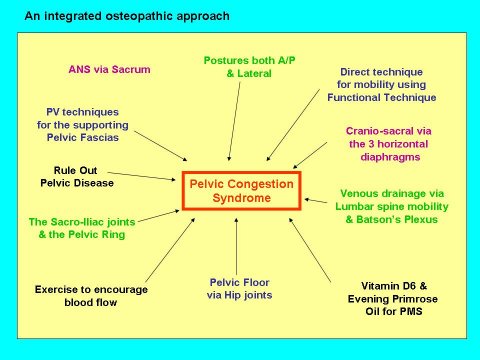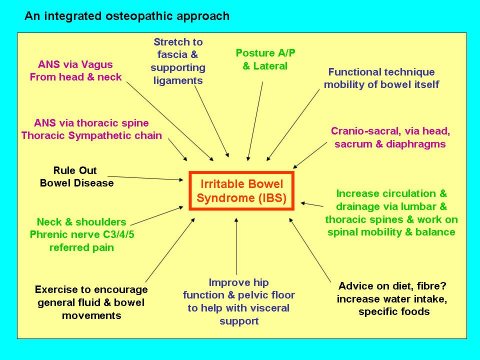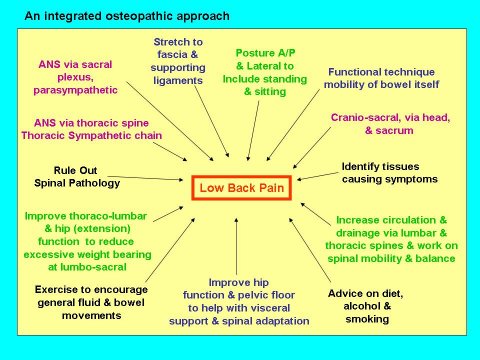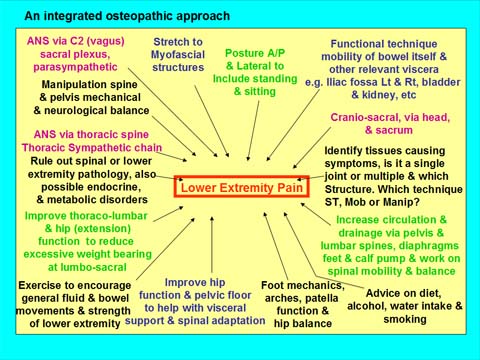
Osteopathy is a system of health care using manual methods of diagnosis and treatment designed to work alongside allopathic medicine to enable a suffering patient to achieve a better state of health.
Is a system used within osteopathy that utilises the direct relationships between the bony articulations & the neuromuscular system, to restore mobility and physiological harmony between the moving parts. It utilises a variety of techniques including soft tissue mobilisation, ligamentous stretch techniques and high velocity short amplitude manipulations. It no longer works on the principles of bones being out of place, more that the normal structural relationships between the body parts is an essential requirement for health. The approach to Manipulative techniques in Osteopathic terms, focuses on the teaching of skills and hand holds which ensure operator and patient safety, control, specificity and effectiveness. Manipulations should be gentle, not painful and specifically non-torsional, using multiple components. High velocity low amplitude techniques can provide rapid local mechanical changes, as well as wider more far reaching effects throughout the circulatory, neuromuscular skeletal and other systems in the body encompassed within Osteopathy.
Is a gentle technique used in osteopathy for the last sixty years and discovered by William Garner Sutherland a pupil of Dr Andrew Taylor Still the founding father of osteopathy. There is an inherent voluntary motion of the brain and the fluid that surrounds the brain and spinal cord. The skull is not one single bone but is a series of bones both big and small that are capable of movement in a co-ordinated and rhythmical fashion. Sometimes this motion becomes disturbed or distorted and this can often predispose the patient to disharmony in other apparently non-related parts of the body. It is a particularly popular technique used in babies and the young because in children the joints between the cranial bones do move a small amount. Birth traumas and strains are often reflected in babies who suffer from some digestive problems and restlessness. Treatment using these techniques is very gentle but specific adjustments to the body tissues not only in the head but also in the related and connected parts all over the body are utilised. It can be used alone or in conjunction with other techniques.
One of the principal tenets of osteopathy is that no one body part or system is alone or independent of any other body part or system. In this way the functions of the viscera or internal organs is dependant on the correct alignment and motion of the supporting bony parts and vice versa. Every organ must have an efficient blood supply, venous and lymphatic drainage in order to survive. The organs all have a complicated system of nerves that take messages to and from them to the spinal cord and the brain. Again this is an example of the body parts working together to create health and harmony. Osteopaths working with the visceral concept make use of these facts to work either directly or indirectly on the internal organs. The techniques employed include direct massage type techniques, cranial techniques, functional techniques as well as manipulative techniques applied to the spine. Examples of conditions that might be approached in this way include some breathing conditions, some digestive disorders, and some problems which afflict the female population, to mention but a few.
Is a dynamic technique that uses a series of palpatory clues to bring about a sense of tension release in the tissues under investigation and thus approach a better state of function. It is used when working primarily on muscles that move the joints and on the fascias supporting the viscera.
There are more technique modalities within Osteopathy, all of which provide their own specific style within the confines known as direct and indirect. Direct meaning pushing towards a sense of barrier or tension and indirect meaning moving away from tension. Harmonic or Rhythmic technique, Muscle Energy technique, Myofascial technique, Strain & Counter-Strain technique to name some others. This is not a complete "osteopathic list", it includes those already mentioned above, but should highlight the global approach to treatment that can be employed by the trained osteopath.
This is a very important aim of Osteopathy as this follows directly the principles laid down by the founder, A T Still. With this in mind, it is important to realise that Cranial, Structural and Visceral techniques are conceptual, evaluative, technical and treatment approaches within the whole system. Using them and the other techniques mentioned as necessary, should ensure a more complete evaluation and therapeutic improvement for the patient. This is demonstrated in the working examples below:




In 1993 the Osteopaths Act was passed in parliament allowing the initiation of the first Statutory Register for Osteopaths in the UK. This has made way for strict rules on registration, ethical codes, personal indemnity and public liability insurance, continuing professional development and of course protection of the public. From April 1998, the new register finally started the process of opening its books to accept and list the Osteopaths of the UK. April 2000 saw the completion of that process and the accreditation of the Osteopathic Training centres in the UK.
If you have any questions that we haven't answered here, or you wish to make an appointment, then please call 020-8524-1505 or call into Churchill Medical Centre.
You are also welcome to contact us via the enquiry form with your questions.
Osteopaths are trained medical professionals who have gained a degree in osteopathy (MOst, including osteopaths with previous qualifications, DO, BOst, BSc Ost, BSc Ost Med) which involves the study of musculoskeletal physiology, anatomy and pathology over a period of 4-5 years.
All osteopaths are fully insured, follow strict guidelines, have undergone enhanced Disclosure and Barring Service (DBS) checks and must be registered with the Government’s regulatory body, the General Osteopathic Council (www.osteopathy.org.uk) in order to maintain an excellent standard of practice.
Osteopathy is a system of diagnosis and hands-on treatment for a wide range of medical conditions which cause pain or discomfort. The main focus of treatment is on the musculoskeletal system (joints, muscles, ligaments, fascia etc). Osteopaths use many of the same diagnostic methods as conventional medicine to establish the cause of physical symptoms whilst taking any internal and external impacting factors into account e.g. lifestyle, work, physical anomalies.
We provide treatment to all age groups, from babies and children to the very elderly. We treat office workers, health workers, manual workers, pregnant women and sports injuries.
Our treatment is adapted to the individual’s needs and requirements.
Osteopathy is proven to be a non-invasive and a safe means of therapy. All practitioners at Daryl Herbert & Associates are highly trained, extremely competent and take great care to ensure patients’ health and wellbeing.
All osteopaths must be registered with the Government’s regulatory body, the General Osteopathic Council (www.osteopathy.org.uk) and complete 30 hours of continued professional development each year in order to maintain an excellent standard of practice. Osteopaths are fully insured, follow strict guidelines and are required to maintain their ongoing education & professional development.
Daryl Herbert's instructional videos provide a visual and audible description of Osteopathic Minimal (short) Lever Mid Range Manipulation Techniques, for osteopaths, physiotherapists, manual therapists, mid to senior level students, graduates and post graduates. Techniques demonstrated look at the basic spinal regions, the spinal junctions, the sacro-iliac joints, ribs and the lower and upper extremity joints.
The new Serola Sacroiliac Back Support Belt are used in thousands of NHS clinics countrywide...
Read More
Goldilocks pillows come in 5 different heights. The height of the pillow is measured as...
Read More
Receipts can be provided for your health insurance...
Read More